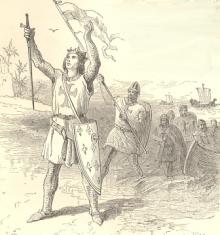In 1291, the Crusader-held city of Acre fell to Muslim forces. It was the last stronghold of the Crusaders, and soon after all the smaller cities held by the Crusaders were abandoned. There would be no further major attempts by the Crusaders on the Holy Lands. The Crusader Spirit, with its fervent desire to reclaim the glorious city of Jerusalem (and gain some of that Muslim wealth as well), simply faded away. In place… was the Inquisition; as the Roman Church stopped persecuting Muslims and Jews so they can start persecuting suspected heretics. This was later to have unpleasant effects for the people living in a large land mass to the west of Europe.
Positive Effects of the Crusades
Medicine, Science, Mathematics, Art, Poetry, Astronomy, Physics, Chemistry… the list goes on. These were all the things brought back from the Islamic Empire that would later spearhead the Renaissance in Europe. Even things like chess and chivalry were not native to Europe (though chess was originally Indian). It was no mistake that the Renaissance first began in Venice, where the populace was generally more worldly, cosmopolitan and exposed to the sophistication of the Muslims through their trading networks. And it was through these trading networks that many other ideas and technologies arrived to Europe from China and Indian.
At first, the Venetians and the Knights Templars held these routes in an iron grip – even though their terms were dictated by the Muslim traders. After the Knights Templars were eliminated, they were replaced only by similar organisations, and trade to Europe flourished. This was because of Europe’s integration into the Silk Road, that expansive trade network (which includes both land and sea routes) stretching from one end of Eurasia to the other. It can be said that the Silk Road was civilisation’s first instance of globalisation. Along this road came silk, spices, paper, printing, banking, paper money, gunpowder, guns, the compass, the sternpost rudder, the lanteen sail, crossbows, advanced agricultural tools, the horse collar, the telescope, matches, chess, playing cards, spinning wheel, china, toothbrushes… and many other inventions. Through these cultural transmissions, Western Europe came to learn of other advanced civilisations to the east of the Islamic Empire, namely a country called Cathay (aka China).
Negative Effects of the Crusades
While the European states wanted to get in touch with these distant lands (not least to spread Christianity around to counter the Muslim “threat”), they were unable to do so through the Islamic Empire. The goods the nobles craved from India and China were all sold to them via Muslim terms, which at times could be quite steep. The European states needed to find new ways to Cathay and the Spice Islands, and it seemed that sailing west would be the only alternative. Or so a guy called Christopher Columbus believed. It is from then onwards that certain peoples had a nasty time at the receiving end of the Spanish Inquisition.
It must be said that the Crusades did not have much effect on the development of the Islamic Empire. However, the process in which Europe forged its own identity in the world stemmed directly from the Crusades; almost entirely on how they related to the Islamic Empire. To the Europeans, Christianity was the one true religion, and Europe was locked into an eternal struggle with the Evil Forces of Islam. The good, true denizens of Europe, with their Christian ways and white skin, were vastly superior to the cruel, vulgar Saracens with their brown and black skin. The one true bastian of faith, Europe, must henceforth set out on another Crusading mission – to spread the One True Word to the lands beyond the Muslim world, where people has not yet had the good fortune to hear the Word of Christ (if indeed they are PEOPLE, as there was genuine doubt during the Spanish Inquisition over whether American Indians were the same “creatures of God” as the Europeans).
This attitude was to have enormous consequences on the way Europe later saw itself and its place in the world. It reached its peak in the racist Imperialist foreign policies of France and Britain during the Industrial Revolution, and puttered out with the genocidal ideas of Adolf Hitler and his attempts at engineering the perfect Aryan race. And it can be said that even though there are no more thuggish Christian knights attacking Muslim cities (woah, wait a minute), the legacy of the Crusades were more far-reaching and devastating than it would initially seem. Luckily, the world has gone past that and the Crusades are now only a historical relic to be learned from, by both Christians, Muslims and and anyone with an interest in the subject.
This concludes the 8-part “The Crusades” series”.

![]()
![]()








